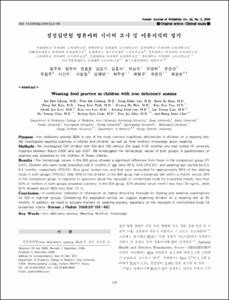철결핍빈혈 영유아의 식이력 조사 및 이유지식의 평가
- Keimyung Author(s)
- Kim, Heung Sik
- Department
- Dept. of Pediatrics (소아청소년학)
- Journal Title
- Korean Journal of Pediatrics
- Issued Date
- 2009
- Volume
- 52
- Issue
- 2
- Keyword
- Iron deficiency anemia; Weaning; Nutrition; Knowledge
- Abstract
- Purpose : Iron deficiency anemia (IDA) is one of the most common nutritional deficiencies in children on a weaning diet. We investigated weaning practices in infants and children, as well as their mothers' knowledge about weaning. Methods : We investigated 1 2 9 children with IDA and 166 without IDA (aged 6-36 months) who had visited 10 university hospitals between March 2 0 0 6 and July 2 0 0 7. We investigated the hematologic values of both groups. A questionnaire on weaning was answered by the mothers of these children. Results : The hematologic values in the IDA group showed a significant difference from those in the comparison group (P<0 .0 5 ). Children who were solely breastfed until 6 months of age were 85%, 3 4% (P<0 .0 5 ), and weaning was started by 6 .3 , 6 .4 months, respectively (P>0 .0 5 ). Rice gruel, boiled rice, and fruit juice accounted for approximately 8 0% of the starting foods in both groups (P>0 .0 5 ). Only 40% of the children in the IDA group had a balanced diet within a month, versus 38% in the comparison group. In response to questions about the necessity of iron-fortified foods for breast-fed infants, less than 50% of mothers in both groups answered correctly. In the IDA group, 42% showed serum ferritin less than 10 ng/ mL, while 92% showed serum MCV less than 72 fL. Conclusion : In conclusion, collection of information on history should be thorough for feeding and selective examinations for IDA in high-risk groups. Considering the adaptation period, we suggest beginning children on a weaning diet at 45 months. In addition, we need to educate mothers on weaning practice, especially on the necessity of iron-fortified foods for
breast-fed infants.
목 적 : IDA는 이유기 영유아에게서 흔한 영양장애이다. 본 연구는 이유기 영유아의 이유식 진행 상황 및 이유지식 등에 관해 알아보았다. 방 법 : 2006년 3월부터 2007년 7월까지 10개 대학병원에 내 원한 6-36개월의 영유아 가운데, IDA로 진단된 129명 및 IDA가 없는 166명을 비교군으로 하여 분석하였다. 대상아의 부모에게서 이유식 진행 상황 및 이유지식을 묻는 문제가 포함된 설문지를 작성하도록 하였다. 결 과 : IDA군의 혈역학적 지표는 IDA가 없는 비교군과 유의한 차이를 보였다(P<0.05). 생후 6개월까지 모유만 먹인 경우는 각각 85%, 34%로 유의한 차이가 있었다(P<0.05). 이유식 시작시기는 각각 6.3개월, 6.4개월로 유의한 차이가 없었다(P>0.05). 처음으로 시작한 음식은 두 군 모두 미음, 죽, 과즙이 80% 이상을 차지하였고, 두 군 간에 차이는 없었다(P>0.05). IDA군에서 첫 1개월 내에 여러 가지 이유식을 골고루 잘 먹게 된 경우는 40 %였고, 비교군에서는 38%였다. 두 군 모두 모유 영양아에서 철분강화 음식의 필요성을 묻는 문제의 정답률이 가장 낮았다. IDA로 진단된 환아에서 ferritin이 10 ng/mL 미만인 경우는 42%였고, mean corpuscular volume (MCV)이 72 fL 미만인 경우는 92%이었다. 결 론 : IDA를 조기에 발견하고 예방하기 위해 이유기 영유아에 있어 철저한 식이력 조사와, 고위험군에 대한 선별 검사가 필요하다. 또 철분이 함유된 이유식을 골고루 섭취하기까지의 적응 기간을 고려하여, 4-5개월에 이유식을 시작하는 것이 보다 안전한 방법으로 생각된다. 마지막으로, 현재의 이유식 지도에 있어 모유 영양아에서 철분 강화 식이의 필요성에 대하여 보호자에게 인식시킬 필요가 있다.
- Alternative Title
- Weaning food practice in children with iron deficiency anemia
- Keimyung Author(s)(Kor)
- 김흥식
- Publisher
- School of Medicine
- Citation
- 장주희 et al. (2009). 철결핍빈혈 영유아의 식이력 조사 및 이유지식의 평가. Korean Journal of Pediatrics, 52(2), 159–166. doi: 10.3345/kjp.2009.52.2.159
- Type
- Article
- ISSN
- 1738-1061
- Appears in Collections:
- 1. School of Medicine (의과대학) > Dept. of Pediatrics (소아청소년학)
- 파일 목록
-
-
Download
 oak-aaa-03548.pdf
기타 데이터 / 230.91 kB / Adobe PDF
oak-aaa-03548.pdf
기타 데이터 / 230.91 kB / Adobe PDF
-
Items in Repository are protected by copyright, with all rights reserved, unless otherwise indicated.